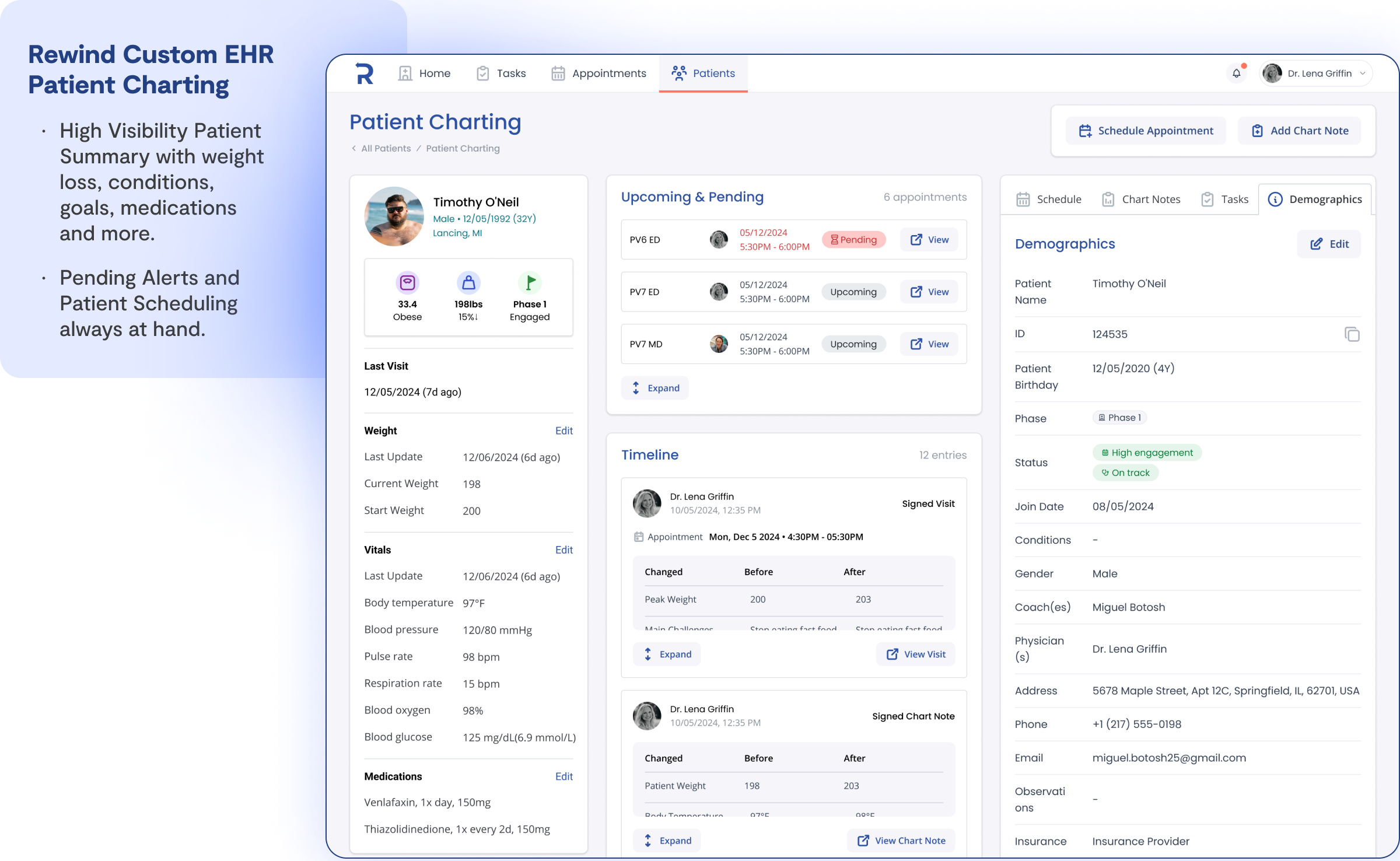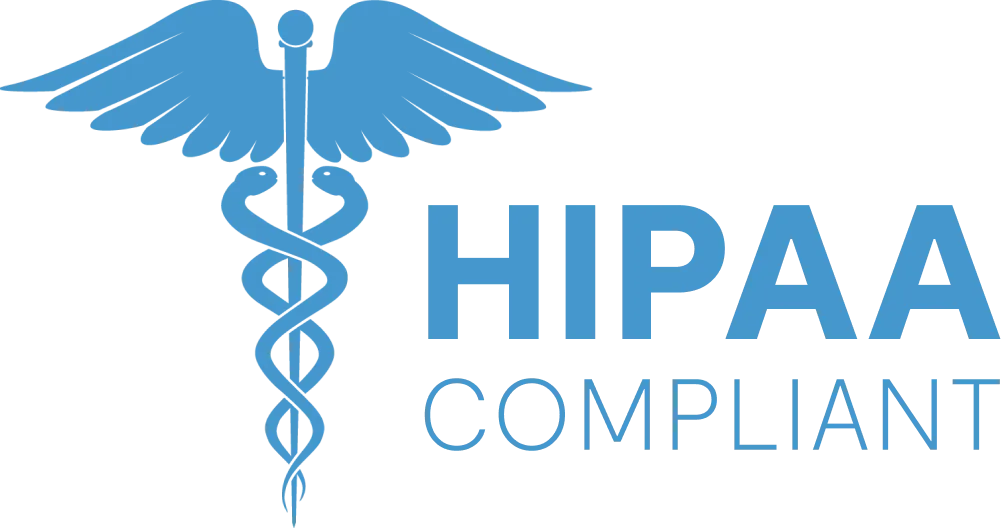
Rewind: breaking down EHR migration barriers
Migrating EHR systems presents significant challenges, especially as many healthcare companies remain tied to legacy applications. According to the Healthcare Information and Management Systems Society, 73% of healthcare providers still rely on outdated systems. Forward-thinking organizations like Rewind are taking a different approach. To ensure that their long-term vision of the business wouldn’t be compromised, they actively sought technical expertise to assess their migration strategy.
In the following sections, we'll detail how our product discovery methodology helped Rewind conduct a safe migration process, minimize risks, and maintain a realistic timeline. Ultimately, this helped them find a solution aligned with their evolving needs.
Finding the right tech stack
Rewind is a comprehensive, clinically backed program designed to help individuals achieve remission from Type 2 diabetes. Its emphasis on personalized support and a structured approach to dietary changes sets Rewind apart from other diabetes and weight management programs. Delivered virtually, the program connects patients with a physician, a registered dietitian coach, and a supportive peer network while facilitating regular check-ins and lessons that drive the behavioral changes necessary for losing weight, keeping it off long-term, and improving metabolic function.
As Rewind's program matured and its patient base grew, its technical requirements evolved. Over time, the team encountered challenges with customizing their existing EHR platform and getting certain features to work “for providers” (increasing efficiency and impact) rather than creating bottlenecks and barriers to delivering a collaborative, high-touch care model. This growing disconnect prompted them to engage Vinta to evaluate potential EHR alternatives and develop a migration strategy to support their expanding vision.

Previous EHR
Rewind initially operated using an out-of-the box EHR designed to support small to medium-sized health and wellness providers and their patients. While the EHR provided some customization options, it mostly focused on providing a ready-to-use solution for health practitioners. Its features are designed to streamline operations such as scheduling, billing, and patient communication.
As Rewind developed its Type 2 Diabetes management program, it found that its needs had evolved beyond what a simpler and standardized EHR platform could support. Rewind required more tailored clinical documentation, enhanced patient information access, advanced metrics, and a workflow that matched its team's productivity style — requirements that began to exceed the EHR’s intended use case.
It became clear that the solution wasn't to stretch existing platform’s limits but to find a platform built for adaptability.
Medplum emerged as the right choice because its headless architecture perfectly aligned with Rewind’s clinical and technical goals of building a customized and agile front-end that can be tailored to the evolving needs of the Rewind provider team.
Medplum
Medplum is an open-source, headless EHR platform. Its architecture allows for extensive customization, enabling healthcare organizations to tailor the EHR to their specific operational needs and workflows. By leveraging the Fast Healthcare Interoperability Resources (FHIR) standard, Medplum ensures that all data is structured and interoperable, facilitating seamless communication between various healthcare systems.
This flexibility makes it particularly appealing for organizations like Rewind, which require a solution that can adapt to their unique service delivery models while maintaining compliance with healthcare regulations.
Medplum provides the modular architecture Rewind required for advanced customization. This allowed Rewind to design specific workflows, integrate real-time metrics, and eliminate external tools for data processing, all while ensuring seamless interoperability with healthcare systems.
The transition wasn’t just about swapping platforms — it was about creating a tailored solution that empowered Rewind’s team to focus on what mattered most: patient care. Based on this evaluation, we endorsed the migration to Medplum and conducted a Product Discovery to ensure it went smoothly.
Derisking EHR migrations: addressing the complexities head-on
A report by the Bloor Group highlights a significant challenge in EHR migration: over 80% of these initiatives exceed their budgets and timelines. The report indicates that cost overruns average around 30%, while time overruns can reach an average of 41%. In addition, such delays can directly jeopardize business timing, investment rounds, and platform user adoption.
To effectively address these challenges, we conducted a thorough Product Discovery, which allowed us to identify potential pitfalls early and develop a comprehensive understanding of Rewind's data landscape before committing to specific implementation decisions. This approach ensured we could make the best technical choices aligned with their platform needs while minimizing the risks inherent to such migrations.
Importantly, our methodology recognizes time as a critical factor in today's fast-paced healthcare technology environment. We designed our Product Discovery to be completed within two weeks, eliminating unnecessary bureaucracy that often consumes valuable patient time. This streamlined framework enables our technical team to gain context quickly and efficiently and create an effective product strategy without sacrificing thoroughness.

Connecting provider and patient gaps
At the outset of our discovery process, we quickly aligned the work to be done by setting the product vision, the main problem, the target audience, challenges, and obstacles. It was essential for us to evaluate everything done in the EHR so far and understand both the opportunities and priorities within our timeframe.
Our team examined three critical aspects of Rewind’s target audience:
- identifying the primary users who would drive adoption;
- recognizing the key decision-makers who could influence organizational buy-in;
- understanding which healthcare professionals had the most pressing need for the solution.
This multidimensional analysis revealed that lead dietitians are pivotal in Rewind's care delivery model, bridging administrative requirements with hands-on patient care while managing their teams. These professionals operate at the intersection of clinical practice and operational management, making their needs particularly important to address.
However, the current healthcare technology landscape presents several obstacles for these key users. They were forced to navigate a maze of disconnected systems while struggling to maintain comprehensive patient records and coordinate care across remote teams. This fragmentation of resources and information created significant bottlenecks in their workflow, ultimately diverting valuable time away from their primary mission: delivering exceptional patient care.
Mapping the most essential steps in the user journey
We mapped the critical elements of the user experience, from initial patient contact through ongoing program management, identifying the essential touchpoints in the practitioner's workflow.
Through this detailed analysis, a central challenge emerged: the fragmented and complex nature of managing patient encounters, scheduling, and task coordination throughout the program's various phases. Healthcare practitioners consistently struggled with systems that created unnecessary complexity and redundancy, forcing them to navigate multiple interfaces for what should be seamless, connected processes.
In response to these findings, we established a clear objective: to develop an intuitive platform that seamlessly integrates charting, scheduling, and task management. This solution would prioritize simplicity and efficiency, allowing practitioners to redirect their focus from administrative processes to what matters most: quality patient care.
The redesigned workflow eliminates unnecessary steps and consolidates key functions, creating a more cohesive and productive experience for healthcare providers.
Designing the user flow
With clear objectives established, our project gained momentum as our design team developed comprehensive mockups that translated these insights into tangible user experiences. These designs seamlessly mapped the provider portal's interface, with the dashboard emerging as the central hub — the practitioners' primary gateway to the system's comprehensive functionalities.
Drawing on insights gathered during user interviews, we crafted a homepage that serves as a command center for healthcare providers. This thoughtfully designed interface consolidates essential information and tools, enabling practitioners to effectively plan and manage their daily responsibilities without the fragmentation they previously experienced.

The patient chart interface represents a significant advancement in information accessibility. When selecting a patient from their list, practitioners encounter a thoughtfully designed screen that intuitively presents comprehensive patient information in a logical, actionable format.
A left panel maintains critical patient data within this interface, including progress indicators, vital signs, and current medications. In contrast, the right panel offers dynamic navigation through appointments, laboratory results, and clinical observations. This dual-panel approach ensures that practitioners have constant access to essential information during consultations, eliminating the frustrating context-switching that characterized their previous workflow.
A robust scheduling system complements the chart functionality with comprehensive calendar management capabilities. Through a unified interface, practitioners can quickly review availability, coordinate appointments, and manage their clinical schedules. This functionality extends beyond individual practitioner use, supporting the entire care team, including nurses and care navigators, in maintaining efficient patient flow.

Practitioners benefit from an intuitive "Start Encounter" feature for active patient visits that streamlines clinical documentation. This tool facilitates real-time data entry and note-taking during patient visits. The platform further supports ongoing care coordination by allowing practitioners to create notes and tasks for team members or future reference, all within this unified interface.
This integrated approach eliminates the constant switching between screens or applications that previously disrupted workflow, maintaining continuity throughout the entire patient encounter.
Outcome: Derisking the development journey
A pivotal outcome of our Product Discovery was the creation of a detailed Technical Assessment that significantly mitigated development risks. This document outlines essential technical implementation guidelines and provides valuable insights into system design choices.
By identifying potential challenges early in the process, we established a clear framework for development, ensuring that all stakeholders had a shared understanding of the technical landscape and requirements. This process was carried out in just two weeks and with just a few alignment meetings, avoiding taking up too much time in the Rewind team's schedule.
The result was a practical development roadmap that equipped Rewind with everything it needed to move forward confidently. This included detailed FHIR resource specifications tailored to their unique clinical data requirements and established strategies for effectively leveraging the Medplum platform's capabilities. The assessment mapped out system integration pathways and carefully aligned the technical architecture with Rewind's specific operational needs.
This strategic approach ensured that the new EHR system would be functionally robust and optimized for seamless provider interaction, directly addressing the workflow challenges identified during our user research. By connecting technical decisions to user needs, we created a foundation for a solution to transform how Rewind's practitioners interacted with their technology and delivered care to their patients.
Next steps: MVP development and upcoming integrations
Following the Product Discovery, we started developing the MVP and fully migrating to the Medplum platform. The following steps include making a new UX and evolving Rewind's UI to establish all the features that practitioners require in their routines.
We also look forward to adding chat via integration with Twilio and the functionality to prescribe medication with DoseSpot, two major deliveries of great value to the platform's users.
These enhancements aim to maximize platform value and improve practitioner workflows. Our team can help you whether you're considering EHR migration or building from scratch.



.webp)






.webp)











%201.webp)
